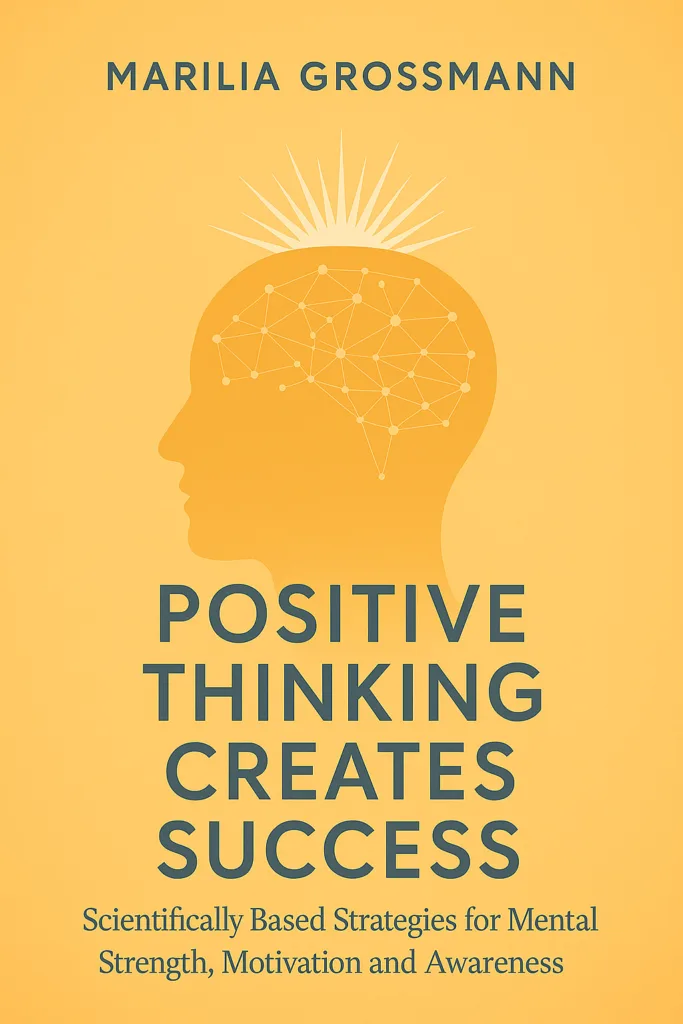eBook – Positive Thinking Creates Success
“Positive Thinking Creates Success” is not a superficial guide — it is a scientifically grounded path to mental clarity and inner strength. It shows how thoughts, emotions, and actions can be consciously directed to sustainably cultivate resilience, motivation, and well-being.
You will learn how to think realistically and positively, build energy and focus, and transform challenges constructively. No empty slogans — but a clear, psychologically based approach for a life of balance and self-efficacy.

-
 AuthorMarilia Grossmann
AuthorMarilia Grossmann -
 LanguageEnglish
LanguageEnglish -
 FormatE-Book (EPUB3)
FormatE-Book (EPUB3) -
 PublisherSelf-Published
PublisherSelf-Published -
 Publication DateOctober 12, 2025
Publication DateOctober 12, 2025 -
 CategoryPsychology / Positive Psychology / Personal Development
CategoryPsychology / Positive Psychology / Personal Development -
 Title“Positive Thinking Creates Success”
Title“Positive Thinking Creates Success” -
 Price$10.00
Price$10.00
✨ Get Your Copy
Positive Thinking Creates Success – your evidence-based path to mental strength, inner clarity, and lasting well-being. Discover how scientifically grounded thinking can transform your life in a conscious and constructive way.
Buy Now – only $10.00📘 E-Book
What Can You Expect from This Book?
- Scientifically grounded strategies for mental well-being
- Practical exercises for clarity, focus, and self-efficacy
- Insights from psychology, neuroscience & behavioral training
- A mindful, realistic-positive approach to everyday life
- Clear structure – with checklists & a 30-day program
🌿 Your guide to inner strength, mental balance, and lived optimism – step by step, with scientific depth and practical application.
✨ Includes bonus material & workbook for everyday use.
“Positive Thinking Creates Success” is a solid path to mental clarity and inner strength: scientifically grounded, clearly explained, and immediately applicable — for anyone who wants to strengthen focus, resilience, and confidence in everyday life.
Positive thinking doesn’t mean sugarcoating reality — it means shaping it consciously. This book shows how to direct your attention, interpretations, and habits so that energy, stability, and agency grow — not through pressure, but with clarity and structure.
“Positive Thinking Creates Success” is an answer to simplistic slogans. It connects psychology with practice so you can think realistically and positively, regulate emotions, and establish effective routines step by step.
- Everyday-ready: small interventions with big impact
- Clear: understandable models from psychology & neuroscience
- Effective: stable habits instead of short-lived motivation
- Realistic-positive: confidence without self-deception
- Extras: checklists & a 30-day program for immediate use
It’s not about doing more, but about doing what matters: directing attention, recognizing thought patterns, simplifying decisions — and following through consistently.
You anchor new ways of thinking so they become part of your identity — through meaningful repetition, clear structures, and a calm, sustainable practice.
- Prompts for focus, emotion regulation & stability
- Exercises for mental energy, clarity, and alignment
- Routines for more calm and self-efficacy
Experience how realistic positive thinking transforms your everyday life — consciously, clearly, and sustainably. Includes a 30-day program, bonus materials, and practical tools.
Discover Now – $10.00Chapter 1 – What Is Positive Thinking, Really?
Chapter 1 – What Is Positive Thinking, Really?
Positive thinking isn’t a superficial smile pasted over difficulties, but a deliberate, reality-based alignment of attention, appraisal, and behavior toward possibilities, resources, and solution-oriented action. This chapter clarifies origins, misconceptions, mechanisms of action, and the necessary balance between realism and a stance of trust—serving as a research-grounded foundation for the entire guide.
Why a Precise Definition Matters
In popular portrayals, “positive thinking” is often confused with naïve optimism—the idea that if you just “believe hard enough,” complexity will dissolve. Scientifically, however, we are dealing with cognitive orientation (perception and appraisal), emotional self-leadership (regulation and access to helpful feelings), and behavioral consequences (priorities, decisions, habits). Positive thinking is thus an integrated mental model for action: it evaluates challenges realistically, focuses on the solution space, and generates energy for action.
A precise definition matters because language shapes reality. If you understand “positive thinking” as mere sugarcoating, you will be disappointed. If you understand it as a mental competency, you discover a trainable system of mental habits that is now broadly evidenced in research, coaching, and therapy. This chapter creates clarity so the concept remains robust—in everyday life, at work, in relationships, and in your inner dialogue with yourself.
1.1 Origins & Development—From Early Thinkers to Modern Positive Psychology
The idea that the quality of our thoughts shapes the quality of our lives predates psychology. Stoic philosophers emphasized that it is not events themselves but our interpretations of them that generate emotional upheaval. This insight anticipates modern cognitive models: between stimulus and response lies a space we can shape—our interpretation. Eastern traditions such as Buddhism paired theory with practice through mindfulness, compassion, and deliberate attentional training; consciousness was to be trained to reduce suffering and cultivate wholesome attitudes.
With the Enlightenment and Idealism, the active role of the subject moved center stage: perception is constructive, not merely passive. This line of thought laid the groundwork for psychological schools that systematically examined how expectations, beliefs, and interpretations shape behavior. William James’s observation that changing attitudes can redirect the course of a life marked the transition to the empirical era of psychology.
The 20th century produced two strands: on one hand, popular self-help touting confidence as a success factor; on the other, cognitive-behavioral therapy approaches (Ellis, Beck) showing that dysfunctional thinking patterns— such as catastrophizing, black-and-white thinking, and personalizing—exacerbate psychological distress and can be changed. Positive thinking thus gained an empirical foundation: not as suppression, but as a trainable orientation in appraisal and action.
Since the late 1990s, Positive Psychology (Seligman, Csíkszentmihályi et al.) has established a research program on strengths, meaning, optimism, gratitude, flow, and self-efficacy. In parallel, neuroscience has documented the brain’s plasticity: repeated, focused cognition alters neural wiring (“what fires together, wires together”). In practice, this means targeted attention and appraisal exercises shape emotional tone, stress responses, and behavior—measurably affecting health, motivation, and performance.
Neuropsychologically, positive thinking is closely linked to activity in the prefrontal cortex—the brain region responsible for self-regulation, planning, and evaluation. At the same time, it dampens the amygdala, the brain’s “alarm system.” This explains why people who think in a solution-oriented way are less likely to remain trapped in stress responses: their nervous system stays more regulated, decisions become clearer, and the release of dopamine and serotonin supports motivation and the joy of learning.
Modern research also shows that optimistic expectations are reflected in the body’s chemistry. They activate reward systems, strengthen the immune system, and demonstrably shorten recovery times after illness or surgery. The mind doesn’t work “magically,” but biologically—through hormonal, neural, and behavioral mechanisms.
Key Takeaways
- Historically, positive thinking bridges philosophy, mindfulness practice, and empirical psychology.
- It’s about interpretive authority over events—not denial of them.
- It is trainable: cognition, emotion, and behavior can be systematically influenced.
1.2 Myths vs. Reality—Distinguishing Naïve Optimism from Grounded Confidence
The most common myth is: “If I think positively, only good things will happen.” This expectation confuses cognition with cosmology. Positive thinking isn’t a metaphysical lever but a mental navigation system: it improves decision quality, persistence, and capacity for cooperation—thereby increasing the probability of favorable outcomes, without guaranteeing them.
Myth 1: Positive = Ignoring Risks
Grounded confidence is clearly distinct from avoidance. It consists of two steps: (1) Realism, a sober assessment of the situation including risks and side effects; (2) Solution focus, the active search for levers of influence. When you consciously factor in risks, you make more robust decisions. Positive thinking therefore doesn’t mean “everything will be fine,” but “I can deal with what is.”
Example: A leader faces a difficult project with unclear resources. Naïve optimism would downplay risks and make unrealistic promises. Grounded thinking recognizes the uncertainties, names them openly, and develops scenarios— this builds trust and enables action.
Myth 2: “Toxic Positivity” as an Ideal
Toxic positivity forbids negative feelings and leaves people voiceless. What’s scientifically sound is emotional integration: reading feelings as data points (e.g., fear as a cue for uncertainty), regulating them (breathwork, reframing, self-compassion), and then acting purposefully. Positive thinking accepts the full range of emotions but prioritizes helpful states for action. Emotional competence is the foundation—not a permanent smile, but balance.
In practice this means: grief may be felt, anger may be voiced—while the focus stays on shaping the situation. “I’m sad because something mattered to me” is a constructive stance that acknowledges both feeling and meaning. Positivity then becomes an inner orientation, not a mask.
Myth 3: Affirmations Are Enough
Verbal self-assertions without evidence can create cognitive dissonance (“I’m absolutely confident” vs. felt uncertainty). Self-talk becomes effective when it is credible: “I’ve handled situations like this before”; “I can define the next concrete step.” This builds self-efficacy rather than self-deception. Research on implementation intentions (Gollwitzer) shows that concrete if-then plans are far more powerful than vague affirmations.
Myth 4: Positive Thinking Is Innate
Dispositions play a role, but skills such as attentional control, cognitive reframing, problem-solving, and interpersonal communication are trainable. Routines (gratitude journaling, solution-oriented daily planning, mental simulation) turn confidence into habit. Neuroscience-based training programs show that after only a few weeks, measurable changes appear in brain areas for self-awareness and emotion regulation.
Reality Check: Grounded Confidence in Five Questions
- Which facts do I know for sure? Which assumptions are sneaking in?
- What risks exist—and how can I specifically mitigate them?
- What is my next doable step (≤ 15 minutes)?
- Which resources (people, knowledge, routines) can I activate?
- In seven days, what would show clear progress?
1.3 Thoughts Shape Behavior—How Awareness Directs Action
Positive thinking operates through three coupled channels: attention, appraisal, and action control. Attention determines which cues we preferentially notice (errors vs. opportunities). Appraisal interprets those cues (threat vs. challenge). Action control translates interpretation into priorities, decisions, and perseverance. The result shows up in micro-actions: how we open a conversation, which question we ask, whether we stick with it when resistance appears.
Attentional Control: From Problem Focus to Possibility Focus
Our perceptual system is limited; what we place in focus shapes our reality. A trained possibility focus systematically looks for resources, levers, and next steps. It doesn’t ignore problems; it treats them as data for solution design. In practice: in meetings, clarify goal clarity first (What should be true after this meeting?) and then the bottleneck question (What, precisely, is holding us back?)—followed by a commitment to one action.
Attention is like a muscle: when trained daily toward solutions, the brain’s internal “default search” shifts. The amygdala reacts less strongly to threat cues; the prefrontal cortex gains control. This fosters calm and capacity for action—especially under pressure.
Practical Example: Stage Fright
A presenter feels her heart racing just before going on stage. She used to read this as a sign of weakness— “I’m nervous, so I must be poorly prepared.” Today she reframes it: “My body is supplying energy so I can be present.” The same physiological response becomes an ally rather than an enemy. Result: clear voice, confident presence, palpable connection with the audience.
Cognitive Reframing: Meaning Is Malleable
Reframing doesn’t change the facts; it changes the lens on the facts. “Failure” becomes “data gained,” “rejection” becomes a fit issue, “stress” becomes an activation state that can be channeled. This meaning-making isn’t sugarcoating but the search for a perspective that is both realistic and action-enabling. Viktor Frankl put it succinctly: “Between stimulus and response there is a space. In that space is our power to choose our response.”
Designing for Action: Thoughts Must Land in Behavior
Confidence without execution dissipates. Effectiveness emerges when thoughts are translated into processes and habits. Three building blocks:
- Implementation intentions: “If X, then I do Y” (e.g., “If I feel resistance, I ask for the smallest next step”).
- Mental simulation: Anticipate obstacles and solutions; failure rates drop when the real moment comes.
- Mini-actions: Cut tasks into 10–15-minute packets to create momentum.
Practical Example: A Feedback Conversation
Negative autopilot: “This will escalate.” → defensive body language → curt, harsh phrasing → self-fulfilling prophecy. Solution focus: “The goal is joint improvement.” → open questions, active listening, clear requests → greater willingness to cooperate. Thinking structured the course of the conversation.
Research on Self-Determination Theory (Deci & Ryan) shows that when people experience autonomy, competence, and relatedness, they naturally think more in solutions. Positive thinking supports exactly these three basic psychological needs—it nourishes self-regulation, self-confidence, and social cooperation.
Interim Summary
Positive thinking is a model for action: it orients perception toward the solution space, builds interpretive robustness, and translates both into concrete, consistent micro-decisions.
1.4 Balancing Reality & Trust—Thinking Positively Without Whitewashing
The most mature form of positive thinking holds tension: between what is and what can become. It doesn’t confuse confidence with certainty and accepts ambiguity without losing the energy to act. This balance grows from three competencies: reality testing, prioritization, and regenerative self-leadership.
Reality Testing: Stay Fact-Based
- Facts list: What do I know for sure? What is plausible? What is pure speculation?
- Base rates: How often do similar undertakings succeed? Under what conditions?
- Pre-mortem: Imagine it failed. What were the causes? What countermeasures can I take now?
Realism isn’t negativity; it’s cognitive hygiene. Only when we see reality clearly can we shape it. A positive thinker doesn’t ignore problems—he classifies them, evaluates their impact, and then decides consciously which to change and which to accept.
Prioritization: Focus Beats Breadth
Confidence concentrates. Instead of launching ten initiatives lukewarm, run two critical levers hot. A simple heuristic: (1) identify high-leverage factors (greatest impact on the goal); (2) check feasibility; (3) set sequence (What must happen first to make everything else easier?). This mindset protects against overwhelm and preserves the psychological energy positive thinking relies on.
Regenerative Self-Leadership: Energy Is a Leadership Variable
Positive thinking requires energy. Sleep, movement, social connection, mindfulness, and purposeful breaks are not “rewards,” but inputs that produce clear cognition and emotional stability. Those who manage energy protect their ability to interpret constructively—especially under pressure. Mental strength is less about sheer willpower and more about energy competence.
In this context, people also speak of psychophysiological coherence: a state in which heart rhythm, breathing, and mind are in sync. Studies show that regular breathing exercises and gratitude reflections foster this state—thereby increasing not only well-being but also cognitive performance.
Mini Playbook: Positive & Realistic in Ten Minutes
- Goal image (60 s): What, objectively, should be different in 14 days?
- Facts (90 s): Gather data, flag assumptions, name risks.
- Levers (90 s): Identify 1–2 factors with the biggest impact.
- Step (120 s): Define and schedule one 15-minute action packet.
- Mental rehearsal (120 s): Obstacle → countermeasure visualization.
- Commit (60 s): Say a brief promise out loud + send a short status note to a trusted person.
Key Ideas from Chapter 1
- Positive thinking is a trainable combination of attention, appraisal, and behavior.
- It differs clearly from toxic positivity: integration, not suppression.
- Reframing changes meaning, not facts—and strengthens capacity for action.
- Balance means: check facts, focus on levers, manage energy.
- Its impact shows up in micro-decisions—every day, in every conversation.
With this foundation, we move into Part II: how inner stance and self-leadership (self-image, emotion regulation, mental toughness) help us embody positive thinking—so it doesn’t collapse in difficult situations but holds.
Chapter 2 – How Thoughts Create Reality
Chapter 2: How Thoughts Create Reality
A new day often begins with a sentence that rises silently within us: “This is going to be difficult,” or “I’m looking forward to today.” Even before we get up, our brain has biochemically tuned itself to that inner tone. Hormones, heartbeat, muscle tension—everything follows the message of the thought. A single thought can color a day’s work, even guide a life. It is like the first brushstroke on a blank canvas.
Our thoughts are not fleeting shadows but electrical impulses that shape neural pathways, form emotional patterns, and thereby steer behavior and perception. What we think becomes our inner landscape—and that landscape determines how we meet the world. Every thought sends out a resonance, influencing the body, chemistry, and direction of life. “A man is what he thinks about all day long,” wrote Ralph Waldo Emerson. Today, neuroscience confirms what philosophers have suspected for centuries.
Modern psychology, neuroscience, and quantum cognition research show: we do not see the world as it is—we see it as we are. Our brain constructs reality from sensory impressions, emotions, memories, and expectations. In this chapter, we explore how this construction arises, how thoughts shape reality, and how we can learn to guide them consciously—toward clarity, trust, and vitality.
2.1 Mental Filters & Perception – The Brain as Architect of Our Reality
The brain is not a neutral receiver but a creative organ. Every second, millions of stimuli reach our senses. Only a fraction makes it into our awareness. The rest is filtered, condensed, discarded. This selection protects us from overload—but it also determines which world we experience.
So-called top-down processes steer this selection. Our expectations, beliefs, and memories shape what we see. Someone convinced that others will reject them interprets even neutral facial expressions as hostile. The brain searches for patterns that confirm the inner assumption—a process known as the confirmation bias. In this way, we manufacture evidence for our own beliefs.
The famous “gorilla experiment” shows how powerfully attention guides perception: participants were asked to count passes between two teams—and failed to notice a person in a gorilla suit walking through the scene. Our focus makes us blind to the obvious. Likewise, in everyday life we overlook kindness or opportunities when our inner filter is set to scarcity.
Thoughts influence not only what we perceive but also how we feel while perceiving. Positive expectations activate the dopaminergic reward system, fostering motivation and openness. Negative thought spirals stimulate the amygdala and put the body on high alert. Perception, emotion, and thought form a closed loop—destructive or healing, depending on our inner stance.
Neuroception, a concept by Stephen Porges, describes how our nervous system unconsciously evaluates whether a situation is safe or threatening. A single anxious thought can be enough to activate the autonomic nervous system and make the world appear dangerous. Only when we learn to recognize these reactions consciously can we soothe them—and recalibrate the filter.
Phenomena such as the illusion-of-truth effect also make this clear: repetition shapes belief. What we hear or think often enough eventually seems true. Attention thus becomes creative energy—it lends substance to thoughts. Mental clarity therefore does not mean controlling every thought, but recognizing which ones we empower.
2.2 Self-Fulfilling Beliefs – Why We Experience What We Believe
Sociologist Robert K. Merton coined the term self-fulfilling prophecy: an expectation generates precisely the behavior that matches it. When we expect failure, we act hesitantly and anxiously, avoid risk—and indeed experience failure. When we expect success, we act more decisively and openly—and produce better results. Thought becomes the cause of experience.
The Pygmalion effect demonstrates this vividly: when teachers are convinced that certain students are especially gifted, those students’ performance rises significantly. Expectation shapes behavior, tone, and attention—and transfers to the other person. The same holds at work: leaders who believe in their teams spark engagement; those who distrust stifle creativity.
The placebo effect follows the same logic. The belief in healing can activate endogenous processes: endorphins are released, the immune system is strengthened, pain is reduced. The opposite, the nocebo effect, shows how negative expectations can worsen symptoms. Thoughts are biochemical impulses with real physiological consequences.
Neuroscientific studies show that positive expectation increases activity in the prefrontal cortex and the dopaminergic system. The brain responds as if the hoped-for event had already occurred. Motivation and persistence rise—a kind of neural advance on success. Here we see the core of the “growth mindset” (Carol Dweck): those who believe they can develop activate different neural networks than those who believe in fixed limits.
Science in brief: Thought → expectation → emotional activation → behavior → experience → new belief. This loop explains why beliefs confirm themselves. Breaking it opens new territory of awareness. The realization: our inner stance is not the result of circumstances—it is their origin.
Example: A woman goes nervously to a job interview. Her thought is, “I’ll surely be too nervous.” Her body responds with tension; her voice trembles; the interviewer senses uncertainty. The experience confirms the expectation. If, however, she begins the morning with the sentence, “I am allowed to show up as I am,” posture, breathing, and energy shift—and the conversation unfolds more openly. Thoughts shape atmosphere.
2.3 The Subconscious as Shaper – Recognizing Deep-Rooted Patterns
Beneath the surface of conscious thought, the subconscious is at work—a vast network of automatic processes. Over ninety percent of our decisions are prepared unconsciously before they reach awareness. There we find emotional memories, early-learned beliefs, bodily patterns. They form the invisible architecture of our personality.
The subconscious does not distinguish between imagination and reality. Those who repeatedly get lost in negative self-talk activate the same brain areas as during real criticism. Stable tracks of stress and self-doubt emerge. These emotional imprints live in muscles, posture, breathing rhythm—in the so-called “body memory.”
Emotional conditioning explains why specific triggers elicit strong feelings: a certain tone of voice, a smell, a look can be enough to reactivate old scenes. The limbic system responds as if the past were happening now. Such implicit patterns cannot be changed by logic alone—they must be re-experienced and re-linked.
The polyvagal theory by Stephen Porges describes how the autonomic nervous system shifts between safety, fight, or shutdown. Many inner blockages are remnants of old survival strategies. The subconscious wants to protect, not sabotage. Only through awareness and compassion can we thank these automatisms and gently transform them.
Example: Someone avoids closeness because they experienced rejection as a child. The mind knows that today’s relationships are different, yet the nervous system signals danger. Through mindful body awareness, breathwork, and safe emotional experiences, the subconscious learns anew: closeness can also be safe. Healing thus becomes a neurological rewrite.
Thanks to neuroplasticity, the brain remains changeable. Every conscious choice, every loving thought alters synapses. Meditation, journaling, or talk therapy create new pathways that overwrite old ones. Awareness is the light that illuminates the shadowed spaces of the unconscious—and transforms them.
2.4 Mental Reprogramming – Retraining Thought Through Mindfulness & Practice
Mental change is training. We cannot wish thoughts away, but we can redirect them. The brain works on a “use it or lose it” principle—connections we activate often grow stronger; unused paths weaken. That’s why mental practice works: it shapes physical structure.
Mindfulness is the first step. It creates distance between the one who thinks and the thought itself. When we recognize that a thought is only a thought, it loses its power. Studies by Richard Davidson show: regular meditation strengthens the prefrontal cortex, responsible for self-regulation, and reduces activity in the amygdala. Calm becomes measurable.
Cognitive restructuring uses the same mechanism. Automatic thoughts are examined and replaced. Example: Instead of “I can’t do this” → “I can learn this.” Instead of “Everything is against me” → “I’ll review what I can influence.” Each deliberate reappraisal weakens old patterns and strengthens new ones.
The 5-Step Model for Conscious Thought Realignment:
- Observe — notice thoughts and emotions without judgment.
- Name — formulate the thought (“I’m thinking that…”).
- Check — is that really true? What counter-evidence exists?
- Replace — choose a helpful, realistic alternative.
- Anchor — repeat and feel the new thought daily.
Visualization is likewise highly effective. Athletes rehearse movements in the mind, musicians practice passages internally—and neural activity mirrors actual performance. The same applies to everyday situations: those who imagine speaking calmly and clearly activate the networks that enable that state. Imagination becomes preparation.
A simple practice: three conscious breaths in the morning. Then the question, “Which quality do I want to live today?”—e.g., trust, joy, focus. In the evening, a review: “When did I feel this quality?” This creates daily mental hygiene. Small rituals, big impact.
Gratitude exercises strengthen positive networks. Studies show: people who regularly note three things they are grateful for change activity in reward areas and reduce depressive tendencies. Gratitude is neural training for abundance.
An inspiring quote by Viktor Frankl captures the essence: “Between stimulus and response there is a space. In that space lies our power to choose.” That is precisely where new reality is born.
2.5 Integration – From Thinking to Being
Insight alone is not enough—it wants to be embodied. New thoughts must be lived, felt, put into motion. Posture, breath, and tone of voice are the bridge between thinking and being. Those who breathe mindfully stand taller; those who stand tall think more freely. The body becomes the resonance chamber of consciousness.
Mental work is therefore holistic: mind, feeling, and body are one. If we think positive thoughts but breathe in fear, the body sends contradictory signals. Only when posture, breath, and thought align does coherence emerge—a state of inner order measurably associated with heart rate variability and mental calm.
Practice Prompt: Choose a guiding sentence for a week that expresses your desired stance, such as “I rest in trust” or “I act from clarity.” Repeat it in the morning upon waking, at midday with conscious breathing, and at night before sleep. Sense how it imprints on body and mood. After seven days, it no longer feels like a thought—but like a natural state.
Thus knowledge becomes wisdom: thinking becomes being, thought becomes feeling, feeling becomes action. The mind creates the structure; the body carries it into the world.
Conclusion – Consciousness as a Creative Force
Thoughts do not create reality by magic, but through the mechanics of consciousness. They shape perception, guide behavior, form emotion, and generate experiences that confirm the original belief. This cycle can imprison us—or set us free.
Conscious thinking means recognizing this mechanism and gently guiding it. Every thought is a seed. Planted in the soil of attention, nourished by repetition and feeling, it grows into experience. The question is: which seeds do we choose to sow each day—fear or trust, scarcity or abundance?
Our inner dialogue is the brush with which we paint the picture of life. Those who learn to speak consciously—with themselves and with the world—shape reality at the deepest level. Step by step, thought by thought, a new way of experiencing emerges. In this way, the mind becomes the architect of destiny—not through force, but through awareness.
And perhaps it all begins with a quiet sentence in the morning: “I am ready to choose my thoughts anew.”
Chapter 3 – Mental Energy & Inner Clarity
Chapter 3: Mental Energy & Inner Clarity
3.1 Linking Mind, Emotion & Body — How Thinking Generates Energy
Mental energy is not an abstract concept but a measurable interplay of neural activity, emotional regulation, and physical vitality. When we think, feel, and act, energy flows through our system in the form of electrical impulses, biochemical reactions, and hormonal signals. The mind influences the body—and the body in turn influences the mind. This feedback loop is the foundation of mental clarity.
From a neuroscience perspective, thoughts arise from the activity of neural networks. Depending on which thoughts dominate, different neurotransmitters are released. Positive, solution-oriented thoughts activate prefrontal areas of the brain, promoting the release of dopamine and serotonin and thereby improving concentration and well-being. Negative, fear-based thinking patterns, by contrast, activate the limbic system—especially the amygdala—and trigger a stress response. The brain’s energy state drops—mental fatigue emerges.
Emotions are not the adversaries of thinking but its energy source. Every emotion is a movement of energy (“e-motion”). It can propel or block us. Those who learn to perceive emotions consciously instead of suppressing them open a direct path to inner strength. Acceptance and presence lead to integration—the nervous system regulates itself, and mental energy flows freely again.
The body is the visible resonance field of this inner process. Posture, breathing, muscle tone, and facial expression mirror the state of mind. An open, upright posture signals safety and confidence to the brain. Studies show that just two minutes of deliberate postural alignment can lower cortisol levels and increase testosterone—with measurable effects on self-confidence and perceived energy.
Mental energy thus arises where mind, emotion, and body come into harmony. It appears not as hectic activity, but as clear, alert presence. A quiet mind consumes less energy and concentrates its power on what matters. This is how that form of inner stability emerges which preserves calm and focus even in demanding situations.
A simple exercise makes this principle tangible: close your eyes, inhale deeply, and gently lengthen your spine. Notice how this small change in posture also shifts inner perception. Thoughts settle, the breath deepens, awareness expands. In that moment, connection arises—and with it, energy.
Embodiment research shows that every posture, gesture, and movement feeds back into neural activity. Smiling—even when initially deliberate—activates emotional networks of joy. Likewise, a grounded stance can convey stability when anxiety is present. This means we can influence the flow of mental energy via the body—anytime, deliberately, and in a trainable way.
An extension of this practice is conscious breathing combined with focused attention. Deep, rhythmic breathing synchronizes brain areas and modulates heart rate variability—a key indicator of stress resilience. Those who spend a few minutes daily breathing in a calm cadence while focusing on positive images or thoughts strengthen neural coherence. Mental energy is therefore not only a product of thinking, but of conscious breathing that orders our thinking.
Regular, mindful attunement reveals: mental energy is no accident, but the result of inner coherence. When thinking, feeling, and acting vibrate in one direction, clarity emerges. Thinking sheds its heaviness and becomes concentrated presence—the quiet strength that grows not out of strain, but out of awareness.
3.2 Stress & Neurochemistry — Why Positivity Balances Hormones
Stress is a natural part of human existence. Without it, there would be no adaptation, performance, or development. But chronic stress upends neurochemical balance—and this is where the link between thinking and energy becomes decisive. What we think about a situation determines how our body experiences it.
The sympathetic nervous system—our “inner accelerator”—responds to threat by releasing adrenaline and cortisol. In the short term, this boosts performance. When the state persists, however, it leads to neural fatigue, reduced neuroplasticity, and increased inflammatory processes. Mental clarity yields to irritability, tiredness, and emotional instability.
Positive thinking acts as a biochemical counterweight. Optimistic, constructive thoughts activate the parasympathetic nervous system—the “inner regulator” for relaxation and recovery. Hormones such as oxytocin, serotonin, and endorphins are released in greater amounts. These messengers foster trust, calm, and focus. Research from Harvard Medical School shows that regular positive reflection—such as gratitude journaling—can measurably lower the stress hormone cortisol within eight weeks.
Neurochemically speaking, positivity is not a naïve wish but a real physiological state. Thought shapes the hormonal profile, and the hormonal profile, in turn, shapes thought. This feedback loop explains why habits like mindfulness, meditation, or conscious breathing are so powerful: they interrupt stress patterns and train the brain to experience calm as the default.
Expectation is especially influential. Placebo research shows that the mere belief in a positive effect activates the same brain areas as the effect itself. In other words: hope is biochemical reality. Those who consciously orient their thoughts toward trust create neurochemical preconditions for healing and energy building.
To harness this mechanism, it helps to reflect daily on one’s stress patterns. A single question suffices: “Which thoughts nourish my body—and which deplete it?” Even this deliberate distinction shifts the neurochemical state. With every moment of conscious positivity, a new neural pattern forms. Neuroscience calls this Hebbian learning: “Neurons that fire together wire together.” Thoughts activated frequently strengthen their pathways. Mental balance thus arises not from force, but from repeated positive experience.
Movement also plays a central role. Moderate physical activity stimulates the release of BDNF (brain-derived neurotrophic factor), a protein crucial for regenerating and forming new neurons. Exercise and joyful movement thus literally promote neural growth. Mental energy needs movement, rhythm, and permeability—physically as well as mentally.
In this light, positive thinking does not mean denying difficulties, but viewing them from a higher level of awareness. It is a choice in favor of a neurochemically healthy state—of balance, focus, and trust in one’s self-regulation.
3.3 Everyday Energy Management — Focus, Recovery, and Deliberate Breaks
Our brain is a high-performance organ that consumes about 20 percent of the body’s total energy—even though it accounts for only two percent of body weight. Mental energy is therefore a finite resource. How we use it determines productivity, creativity, and well-being. In a world of constant stimuli, many people lose energy not through work, but through mental distraction.
Focus is the art of concentrating energy. When we attend to one thing, the brain’s energy consumption drops in other areas. Multitasking, however, fragments attention—the neural networks must constantly switch, which costs energy. Studies show that multitasking can reduce efficiency by up to 40 percent. Mental clarity thus arises not from more activity, but from deliberate focusing.
Equally important is the capacity for recovery. Rest is not a luxury, but a biological necessity. During phases of deliberate rest, the brain’s default mode network reorganizes, memories consolidate, and neural waste is cleared. Sleep, meditation, walks in nature, or simple idleness are therefore not interruptions, but energy sources.
A balanced energy budget emerges when tension and relaxation alternate rhythmically. Performance and pause are not opposites but a biological equilibrium—like inhaling and exhaling. Those who manage their energy wisely recognize early signs of overload: declining concentration, inner restlessness, emotional irritability. Rather than fighting these, the wiser path is a deliberate break. It prevents burnout long before it arises.
Mental strength is evidenced not by nonstop output but by the ability to manage energy intelligently. A brief mindful minute between tasks can re-engage the prefrontal cortex and calm the emotional center. Those who cultivate these micro-breaks establish a stable energy foundation in daily life—and experience a clarity born of inner balance.
A helpful method is working with the rhythm of so-called ultradian cycles—natural 90- to 120-minute intervals in which our energy rises and falls. After about an hour and a half of intense focus, performance declines and the brain calls for recovery. Following this natural tempo and taking a short, deliberate break after each cycle increases overall output without exhaustion.
Mindfulness anchors—brief, recurring moments of conscious presence—also stabilize the mental battery. One deep breath, a quick body scan, a glance at greenery: tiny actions with big effects. These micro-rituals structure the day and create an energy flow that stems not from discipline but from rhythm.
Another factor is environmental quality. Light, noise, colors, and social atmospheres influence the mental energy budget more than we realize. An orderly, bright workspace can improve concentration by up to 30 percent. Likewise, contact with nature acts like a biological reset: just 20 minutes outdoors has been shown to lower cortisol. Energy is not created only within; it is nourished by spaces and resonance fields.
Ultimately, conscious energy management is an act of self-respect. Protecting one’s internal battery is not selfish but sustainable—in service of one’s own clarity and the quality of one’s contribution. Energy follows attention. Those who steer their attention wisely cultivate mental abundance rather than depletion.
3.4 Mental Hygiene — Rituals for Clarity & Protection from Overload
Just as the body needs daily care, the mind requires regular cleansing. Mental hygiene means freeing awareness from unnecessary ballast—from destructive thoughts, toxic information sources, and unconscious self-talk. Without deliberate care, mental “dust” accumulates, clouding clarity and tying up energy.
A central ritual of mental hygiene is deliberate pausing. It creates distance between stimulus and response. Those who pause regularly train the ability to observe thoughts instead of following them blindly. This metacognitive awareness lies at the core of many mindfulness practices and is demonstrably associated with increased activity in the anterior cingulate cortex—an area that supports self-regulation and emotional control.
The quality of our inner language also shapes our inner state. Words are neural commands: they generate emotions, bodily reactions, and thus energy flows. Meeting oneself with respect and self-compassion activates reward and motivation networks. Negative self-talk, on the other hand, ramps up amygdala activity and drains the system. Mental hygiene therefore begins with linguistic mindfulness—in the inner dialogue as much as in communication with others.
Digital overstimulation is another challenge of our time. Every notification and message activates the dopaminergic reward system. Short-term, there is a burst of energy; long-term, exhaustion. Conscious media consumption—such as fixed offline periods or digital fasts—is part of mental self-care. The ability to disengage from overstimulation is a modern form of meditation.
Gratitude, finally, strengthens the mind’s immune system. Those who focus daily on what is positive train the brain toward perceptual balance. It is as if the mental filter were being cleaned and realigned. Gratitude has been shown to buffer stress and increase resilience—it is the simplest and most profound ritual for inner clarity.
Mental hygiene also includes clear emotional boundaries. Not every mood we sense originates within us. Highly sensitive or empathic people often feel the energies of others. A brief inner ritual—such as a conscious breath with the intention “I remain in my own energy”—can stabilize here. In this way, personal clarity is preserved without being absorbed by the environment.
Other powerful rituals include journaling, deliberate evening reflection, and mental “detox”: writing down burdensome thoughts to let them go; reviewing which information sources truly nourish; and allowing silence in which awareness orders itself. Mental hygiene is not withdrawal, but conscious self-leadership. It guards against overload, preserves mental agility, and keeps mental energy available over the long term.
Tending the mind like a garden lets clarity emerge as a natural consequence of mindfulness, not as an exception. The daily care of this garden—through rest, reflection, movement, mindful language, and gratitude—turns positive thinking into lived reality. Thus mental energy becomes the basis of a fulfilled, clear, and powerful life.
3.5 Essence & Application — Energy as a Deliberate Way of Living
Mental energy is not a matter of chance but a skill that can be trained and maintained. It emerges when mind, emotion, and body act in harmony—when thinking is connected rather than fragmented, when feeling is not suppressed but understood. This balance is not a one-time state but a living process renewed daily.
The practice of mental clarity begins with small things: a conscious breath before a decision, a moment of stillness amid overstimulation, a grateful thought at the end of a long day. Such micro-actions are the building blocks of inner stability. With every deliberate pause, every clear thought, and every stance of appreciation, neural coherence forms—and with it, the ability to direct energy rather than lose it.
Mental energy is therefore not only a personal power source but a resonance field that inspires others. People with a clear, calm presence radiate stability. They do not think louder, but deeper. In their presence, others’ minds grow calmer and bodies more at ease. Energy is contagious—like fear, only in a healing form.
The essence of this chapter can be summed up in one sentence: awareness directs energy, and energy shapes reality. Those who learn to consciously shape their inner state become architects of their lives. Mental clarity is thus not a luxury but a form of self-leadership—a path on which thinking, feeling, and being vibrate in harmony.

Show more info
Your step-by-step guide to a healthier life:
Clear routines, simple recipes, and practical tips for more energy and well-being.

Show more info
A 30-day plan for strong gut health:
With targeted nutrition tips, step-by-step guidance, and everyday recommendations.

Show more info
Understand & overcome depression:
Solid knowledge, root causes, and proven paths to stability and hope.

